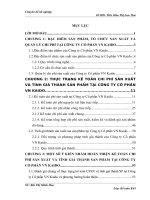a0103 apress beginning android tablet games programming nov 201 morebook vn 9178
Bạn đang xem bản rút gọn của tài liệu. Xem và tải ngay bản đầy đủ của tài liệu tại đây (1.21 MB, 7 trang )
Download from Wow! eBook <www.wowebook.com>
For your convenience Apress has placed some of the front
matter material after the index. Please use the Bookmarks
and Contents at a Glance links to access them.
Contents at a Glance
About the Author.................................................................................................... ix
About the Technical Reviewer ................................................................................ x
Acknowledgments ................................................................................................. xi
Chapter 1: Setting Up Android 3.0 Java Development............................................1
Chapter 2: Creating Simple Games with Sprites and Movement ..........................27
Chapter 3: Creating Gathering User Input.............................................................47
Chapter 4: Adding Sound Effects, Music, and Video .............................................69
Chapter 5: One-Player Game with Obstacles ........................................................87
Chapter 6: A Ball and Paddle Game ....................................................................103
Chapter 7: Building a Two-Player Game .............................................................121
Chapter 8: A One-Player Strategy Game Part I ...................................................137
Chapter 9: A One-Player Strategy Game Part II ..................................................151
Chapter 10: Publishing the Game .......................................................................167
Appendix A: Testing Android Games on a Real Device .......................................179
Index ...................................................................................................................181
iii
CHAPTER 1
Setting Up Android 3.0 Java
Development
This book teaches you to create your own games for Android 3.0 tablets. After reading and working
through its examples, you’ll have gained command over the sensors, touchscreen, network capabilities,
and processing power of the many new tablet computers. Does that sound daunting? It isn’t. Instead of
going through the drudgery of developing stodgy corporate apps that locate a store or present a coupon,
you’ll know how to make fun and intriguing games. If you’ve done some game development in the past,
you may be pleasantly surprised to learn how simple the Android system makes this process when
compared to traditional PC and console game development.
Although no book ever written can take you from newbie to game programming guru, the
foundation presented in this book will let you make any of your 2D game ideas into a reality. This book
makes the programming as simple as possible in order to concentrate on the more creative aspects of
game development.
What Is Android?
Android is very special, and you’ll gain much more appreciation for it as you get into the programming.
The movement of many handset makers to create tablets running the Android OS created a huge market
for the games you’ll make. This section gives you a rundown of Android’s features and history.
The Beginnings of Android
In 2003, Android began as a small Silicon Valley startup company with the aim to create a more
interactive and helpful interface for smartphones. Google quickly snatched up the company in 2005 as
part of its push to enter the mobile phone market. After Google acquired it, the first Android OS was
soon released during 2007. In subsequent years, Android went through many revisions (more than seven
major changes) that made it one of the leading operating systems for smartphones, with some saying
that Android has nearly 50% of mobile devices.
The revisions to Android are very important to understanding how development works. Google
worked hard to ensure backward compatibility in its version of Android; however, applications generally
are designed to work for a select couple of Android editions to guarantee the best performance and user
experience. The version called Froyo is still the most popular for developers, but the later versions are
gaining steam as more modern devices like tablets require more powerful operating systems.
The following list of Android versions, along with their current market share, illustrates which
versions remain popular and therefore are of interest to developers. The creative name given to each
version by Google is next to the edition number. Developers often go by these names rather than merely
1
CHAPTER 1 SETTING UP ANDROID 3.0 JAVA DEVELOPMENT
the numbers. Keep in mind that with the exception of Android 3.0, all versions of the OS were designed
for phones exclusively:
•
Android 1.5 Cupcake (2.3%)
•
Android 1.6 Donut (3.0%)
•
Android 2.1 Éclair (24.5%)
•
Android 2.2 Froyo (65.9%)
•
Android 2.3 Gingerbread (1.0%)
•
Android 2.3.3 Gingerbread (3.0%)
•
Android 3.0 Honeycomb (0.3%)
If you’re interested in checking the current market share of the various versions, go to
/>After examining this list, many would say that you should be making games for Froyo because it has
a huge lead in market share over other versions. The reason for Froyo’s prevalence is that it’s installed on
many simpler older phones that can only get updated versions through a complicated process. These
devices will slowly become inconsequential as the newer versions take center stage. To some extent,
making games for the majority of users makes sense; however, every day new users are buying more
modern phones that use the later versions. Also, perhaps the most important point is that hundreds of
thousands of apps are playable on the Froyo version, and it’s increasingly difficult to stand out.
With that being said, this book teaches you to designs games for the latest edition (Honeycomb) for
two reasons. First, Honeycomb is the only version optimized for tablets, which are much more
immersive and fun than any smartphone. Second, Android tablet computing is growing at a huge rate as
more companies release tablets that can compete with Apple’s iPad. With the failure of webOS, Android
and iOS are the only contenders in the tablet market. Microsoft has also come out with its own operating
system, but it has not yet garnered significant market share. Google’s often-quoted statement about
500,000 Android devices being registered each day gives you a sense of how fast this market is
expanding.
Android 3.0 Features
Honeycomb is a huge advance from the previous Android versions. Designed to utilize a much larger
screen and more powerful processor, Android 3.0 lets developers expand their usually modest
smartphone games. Many of the new features are user-interface changes that make the desktop
accessible to users with a screen that is several times bigger than a smartphone screen. For example,
typical phones have two- to three-inch screens, whereas tablets boast impressive nine- to ten-inch
screens. These updates are convenient; however, game developers concentrate more on the updates to
speedier graphics rendering and the new sensors and network abilities of the operating system.
Not all games use all of these features, but it’s crucial to consider their importance in designing
unique games. The larger screen is in itself an update worth noting. The high-resolution screens demand
artwork that is scalable and visually appealing. Many Android tablets have landed on 1280 × 800 as their
screen size. This is comparable to the resolution that many computer screens still use. In this case, the
graphics must approximate the images used in computer games.
Table 1-1 list major changes to Android 3.0 of particular interest to game developers.
2
About the Technical Reviewer
Jelani John is a freelance developer and animator from Brooklyn. He enjoys
making games and playing with new technologies. You can find him at
www.jelanijohn.com.
x
Acknowledgments
Frank Pohlmann, Editorial Director at Apress, gave me the tremendous opportunity to write this book. I
am very grateful for your advice and coaching as we hashed out what the book would look like.
A very special thanks to Anita Castro, the coordinating editor, who pushed me through the
sometimes arduous task of completing the chapters, graphics, and code for this book. You gave me some
incredible advice and were very patient with me throughout the process.
Thank you to all of the editors and reviewers who worked on the project with me. Your
technical advice, wordsmithing, and organizational ideas made this book immeasurably better.
I have also had many great mentors and colleagues who prompted me to do what I thought was
impossible. Thank you to Dave Briccetti for introducing me to the art of teaching computer science. Paul
Spinrad was an amazing editor for Make Magazine who inspired me to take on this project after I read
his two stunning books. Paul gave me good pointers, was patient with me, and refused to get angry
despite my fickleness. I am very grateful to you.
xi








